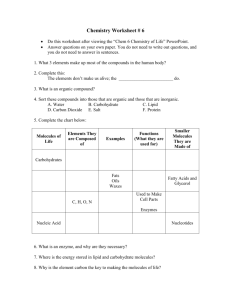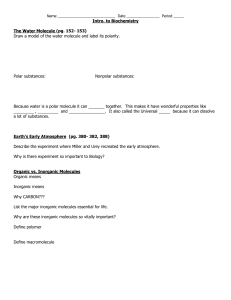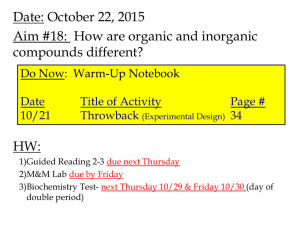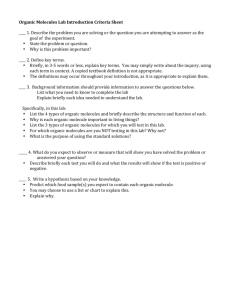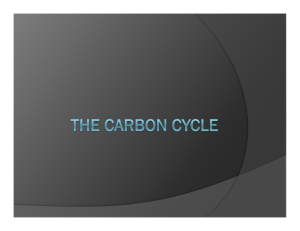Introduction to Organic Chemistry
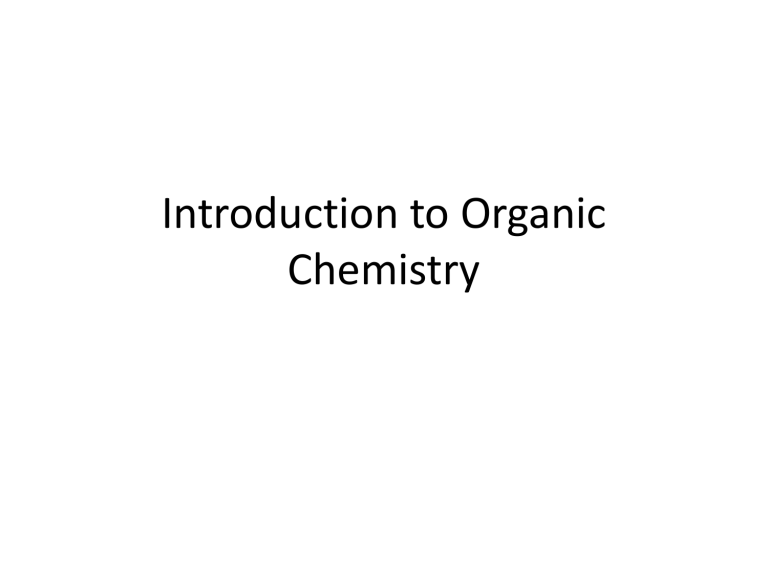
Introduction to Organic
Chemistry
Composition of Living Things
• What makes up living things?
• How do we get these building blocks?
• The science of macaroni salad
– https://www.youtube.com/watch?v=4WR0_gEEZ9I
Composition of Living Things
• Which atoms make up living organisms?
– Of the 92 elements that naturally occur on Earth, about 25 are found in organisms
– Just 4 make up about 96 % of a human body’s mass
( Meet the Elements )
• Carbon ( C )
• Hydrogen ( H )
• Oxygen ( O )
• Nitrogen ( N ) https://askabiologist.asu.edu/content/atoms-life
CHOPKINS CaFe Mg
This sounds like an excellent small restaurant…say it out loud.
http://cnx.org/content/m45998/latest/?collection=col11496/1.6
Inorganic vs. Organic Compounds
• Historically, compounds isolated from plants and animals were deemed organic while those traced back to minerals were inorganic.
– Organic compounds typically had carbon ( C )
• However, some molecules contain C, such as calcium carbonate (CaCO
3
) and elemental forms of carbon
(diamond and graphite), that are clearly inorganic.
• Organic compounds are thus defined as containing BOTH carbon and hydrogen .
Organic vs. Inorganic Compounds
Organic
Substance that contains BOTH carbon and hydrogen
*General rule is that they contain carbon
Types Essential to Life:
Carbohydrates (C
6
H
12
O
6
)
Lipids
Nucleic Acids
Proteins
Inorganic
Substance that does NOT contain BOTH carbon and hydrogen
*Inorganic Examples with C:
Carbon Monoxide (CO), Carbon
Dioxide (CO
2
), Cyanides
Types Essential to Life:
Water (H
2
O)
Salts (NaCl)
Acids (HCl)
Bases (HCO
3
-)
Carbon-Based Molecules
• Carbon-based molecules form the structure of living things and carry out most of the processes that keep organisms alive .
• Carbon can form up to 4 bonds.
• Three fundamental structures:
– Straight Chains
– Branched
– Rings http://www.esrl.noaa.gov/gmd/outreach/isotopes/images/Carbon_atom.jpg
Fundamental Structures of Carbon-
Based Molecules
• It may seem simple… Share with your partner the different configurations above (relate the name to their structure) and how they show that carbon is forming 4 bonds.
Monomer vs. Polymer
• Small molecules act as subunits of the entire molecule.
– Monomer : each subunit in a complete molecule
– Polymer : a large molecule, or macromolecule, made of many monomers bonded together.
• All of the monomers can be the same (i.e. carbohydrates) or different (i.e. proteins).
http://www.wikihow.com/Put-On-a-Bicycle-Chain
Building Up and Breaking Down Molecules
Forming larger molecules Breaking bigger molecules into smaller ones
Dehydration Synthesis Hydrolysis http://images.tutorvista.com/cms/images/81/dehydration-and-hydrolysis.png
Dehydration Synthesis – Build Up
• Synthesis
– to create (to put together, to make bigger)
• Dehydration
– to take out water
+ H
2
O
+ H
2
O
Ex: Dehydration Synthesis of ATP
**ATP is a molecule that stores readily usable energy for cells.
A phosphate group is added to the end.
In doing so, energy is stored to be used by the cell.
This is a VERY important molecule in biology!
http://www.mikeblaber.org/oldwine/BCH4053/Lecture05/atp_hydrol01.gif
Hydrolysis – Break Down
• Lysis
– to split
• Hydro
– water (H
2
O)
+ H
2
O
This is a VERY important molecule in biology!
Ex: Hydrolysis of ATP
A phosphate group is cleaved (removed) from the end.
In doing so, energy is released to be used by the cell.
http://dm.ncl.ac.uk/helencollard/files/2009/04/atp.gif
Four Main Classes of Organic
Macromolecules
Each of these molecules are made up of smaller parts. Understanding what they are made of helps you understand their function.
1. Lipids
2. Carbohydrates
3. Nucleic Acids
4. Proteins
Macromolecule Table
We will come back to this table after each macromolecule we cover. It may be a good idea to tab this page with something like a sticky note.
Proteins Macromolecule Lipids Carbohydrates Nucleic
Acids
Types of Atoms
Monomers made of
Function(s)
Examples
Sketch
